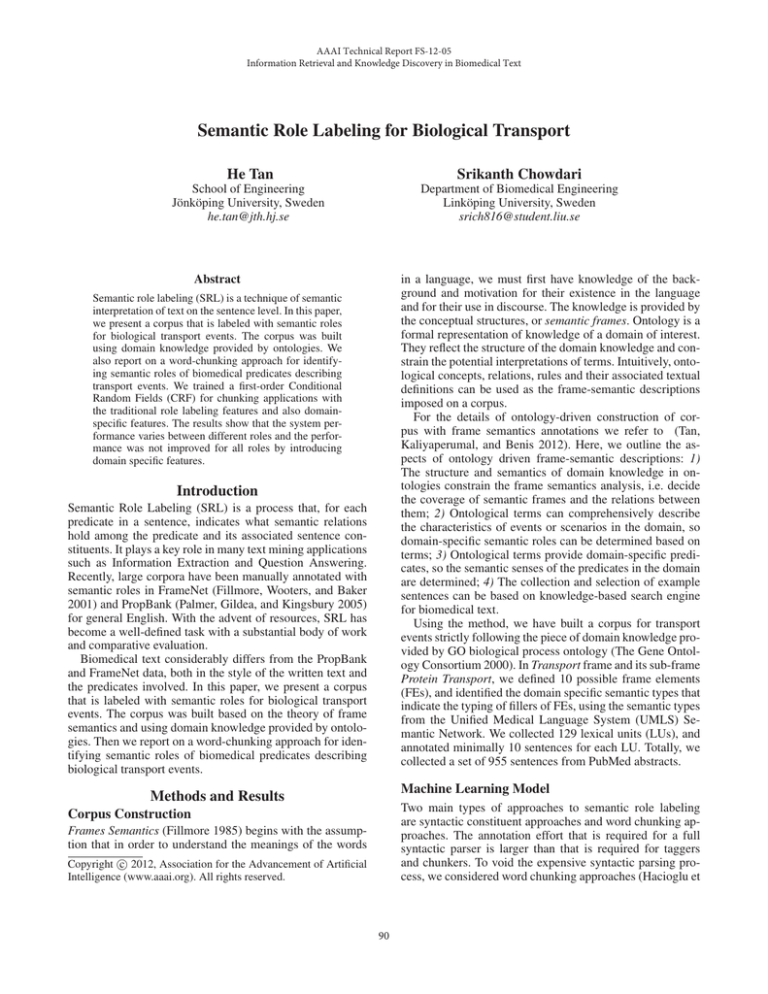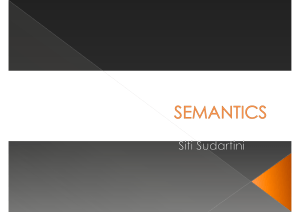
AAAI Technical Report FS-12-05
Information Retrieval and Knowledge Discovery in Biomedical Text
Semantic Role Labeling for Biological Transport
He Tan
Srikanth Chowdari
School of Engineering
Jönköping University, Sweden
he.tan@jth.hj.se
Department of Biomedical Engineering
Linköping University, Sweden
srich816@student.liu.se
Abstract
in a language, we must first have knowledge of the background and motivation for their existence in the language
and for their use in discourse. The knowledge is provided by
the conceptual structures, or semantic frames. Ontology is a
formal representation of knowledge of a domain of interest.
They reflect the structure of the domain knowledge and constrain the potential interpretations of terms. Intuitively, ontological concepts, relations, rules and their associated textual
definitions can be used as the frame-semantic descriptions
imposed on a corpus.
For the details of ontology-driven construction of corpus with frame semantics annotations we refer to (Tan,
Kaliyaperumal, and Benis 2012). Here, we outline the aspects of ontology driven frame-semantic descriptions: 1)
The structure and semantics of domain knowledge in ontologies constrain the frame semantics analysis, i.e. decide
the coverage of semantic frames and the relations between
them; 2) Ontological terms can comprehensively describe
the characteristics of events or scenarios in the domain, so
domain-specific semantic roles can be determined based on
terms; 3) Ontological terms provide domain-specific predicates, so the semantic senses of the predicates in the domain
are determined; 4) The collection and selection of example
sentences can be based on knowledge-based search engine
for biomedical text.
Using the method, we have built a corpus for transport
events strictly following the piece of domain knowledge provided by GO biological process ontology (The Gene Ontology Consortium 2000). In Transport frame and its sub-frame
Protein Transport, we defined 10 possible frame elements
(FEs), and identified the domain specific semantic types that
indicate the typing of fillers of FEs, using the semantic types
from the Unified Medical Language System (UMLS) Semantic Network. We collected 129 lexical units (LUs), and
annotated minimally 10 sentences for each LU. Totally, we
collected a set of 955 sentences from PubMed abstracts.
Semantic role labeling (SRL) is a technique of semantic
interpretation of text on the sentence level. In this paper,
we present a corpus that is labeled with semantic roles
for biological transport events. The corpus was built
using domain knowledge provided by ontologies. We
also report on a word-chunking approach for identifying semantic roles of biomedical predicates describing
transport events. We trained a first-order Conditional
Random Fields (CRF) for chunking applications with
the traditional role labeling features and also domainspecific features. The results show that the system performance varies between different roles and the performance was not improved for all roles by introducing
domain specific features.
Introduction
Semantic Role Labeling (SRL) is a process that, for each
predicate in a sentence, indicates what semantic relations
hold among the predicate and its associated sentence constituents. It plays a key role in many text mining applications
such as Information Extraction and Question Answering.
Recently, large corpora have been manually annotated with
semantic roles in FrameNet (Fillmore, Wooters, and Baker
2001) and PropBank (Palmer, Gildea, and Kingsbury 2005)
for general English. With the advent of resources, SRL has
become a well-defined task with a substantial body of work
and comparative evaluation.
Biomedical text considerably differs from the PropBank
and FrameNet data, both in the style of the written text and
the predicates involved. In this paper, we present a corpus
that is labeled with semantic roles for biological transport
events. The corpus was built based on the theory of frame
semantics and using domain knowledge provided by ontologies. Then we report on a word-chunking approach for identifying semantic roles of biomedical predicates describing
biological transport events.
Machine Learning Model
Methods and Results
Two main types of approaches to semantic role labeling
are syntactic constituent approaches and word chunking approaches. The annotation effort that is required for a full
syntactic parser is larger than that is required for taggers
and chunkers. To void the expensive syntactic parsing process, we considered word chunking approaches (Hacioglu et
Corpus Construction
Frames Semantics (Fillmore 1985) begins with the assumption that in order to understand the meanings of the words
c 2012, Association for the Advancement of Artificial
Copyright Intelligence (www.aaai.org). All rights reserved.
90
Total
955
TE
786
TO
200
TDS
320
TC
501
TL
112
TP
92
TT
46
TDR
4
TA
69
TPL
31
Table 1: The number of sentences contain the FEs. Transport Entity (TE), Transport Origin (TO), Transport Destination (TDS), Transport Condition (TC) are core FEs. Others are Transport Location (TL), Transport Path (TP), Transport Transporter (TT),Transport Direction
(TDR), Transport Attribute (TA), Transport Place (TPL). For the FE definitions we refer to (Tan, Kaliyaperumal, and Benis 2012)
traditional features
traditional + domain specific features
FE
All
TE
TD
TO
TC
All
TE
TD
TT
TC
R
0.56 0.70 0.75 0.61 0.18 0.56 0.74 0.67
1.0
0.21
P
0.59 0.66 0.93 0.61 0.20 0.57 0.73 0.75 0.60
0.19
A
0.85 0.97 0.77 0.73 0.89 0.84 0.92 0.75 0.50
0.90
Table 2: Unlabeled precision (P) and recall (R), and labeled accuracy (A).
al. 2004). The word chunking approaches convert the SRL
problem into a word classification problem by selecting appropriate labels for each word in the phrase. These labels are
a combination of a B(eginning), I(nside) or O(utside) prefix
that indicates the location of the word within the role, and a
role suffix that indicates the type of the role.
CRF for sequence labeling offer advantages over both
generative models and classifiers applied at each sequence
position (Sha and Pereira 2003). In this work we used the
implementation of first-order chain CRF to chunking applications from LingPipe (http://alias-i.com/lingpipe). For the
purposes of our experiments, 101 sentences were selected
at random from our corpus and reserved as the test set. The
remaining 854 sentences were used as the training data.
Two groups of features are used in training and testing.
The first group include the traditional role labeling features:
the text of words and predicates, the stem of predicates, the
voice of predicates, the part-of-speech of words and predicates, the BIO tag for the phrases that includes the word
(e.g. B-NP, I-NP and O) and the location of words relative
to the predicate (i.e. ”before”, ”after” and ”-”). The output
from the MetaMap tools (2011) (Aronson and Lang 2010)
processing executed on corpus sentences are extracted into
another group of features. The features provided from the
MetaMap output include the domain specific noun phrases
identified in the sentences, the head of the noun phrase, and
the UMLS Semantic Types of the noun phrase.
The SRL task can be viewed as a two step process in
which boundaries are first identified and then FEs are labeled. Therefore, we evaluated the system in labeled precision (P) and recall (R) and labeled accuracy (A). Tabel 2
presents P, R and A values when the model were trained using the traditional role labeling features, and the traditional
features together with domain specific features. The results
show that the system has performed better in identifying the
type of the FEs, than for word chunking. The performance
varies greatly between different FEs. Table 1 gives all the
possible FEs we identified for transport events, and the number of sentences containing the different FEs. When the system was trained with the traditional role labeling features,
it performed best on the TE, TD and TO. When the system
was trained with the traditional features together with domain specific features, it performed best on the TE, TO and
TT. In both cases the system performed worst on the TC. It
also shows that the performance is not always improved for
all FEs by introducing domain specific features. As a whole
the system had similar performance when it was trained with
and without domain specific features.
Conclusions
In this paper, we present a corpus that is labeled with semantic roles for biological transport events. It was built using
ontological domain knowledge. We also report on a wordchunking approach for identifying semantic roles of biomedical predicates describing transport events. The results show
that the system performance varies between different roles
and the performance was not improved for all roles by introducing domain specific features. In the future work, we aim
to extend the corpus to cover other biological events. We intend to develop a environment supporting corpus construction using ontological domain knowledge. We also intend to
explore features based on full syntactic parses in machine
learning models.
References
Aronson, A. R., and Lang, F.-M. 2010. An overview of
metamap: historical perspective and recent advances. JAMIA
17(3):229–236.
Fillmore, C. J.; Wooters, C.; and Baker, C. F. 2001. Building
a large lexical databank which provides deep semantics. In
Proceedings of the PACLIC.
Fillmore, C. J. 1985. Frames and the semantics of understanding. Quaderni di Semantica 6(2):222–254.
Hacioglu, K.; Pradhan, S.; Ward, W.; Martin, J. H.; and Jurafsky, D. 2004. Semantic role labeling by tagging syntactic
chunks. In Proceedings of CoNLL 2004 Shared Task, 110–
113.
Palmer, M.; Gildea, D.; and Kingsbury, P. 2005. The proposition bank: an annotated corpus of semantic roles. Computational Linguistics 31:71–105.
Sha, F., and Pereira, F. 2003. Shallow parsing with conditional random fields. In Proceedings of NAACL HLT 2003,
134–141.
Tan, H.; Kaliyaperumal, R.; and Benis, N. 2012. Ontologydriven construction of corpus with frame semantics annotations. In CICLing 2012, Part I, LNCS 7181, 54–65.
The Gene Ontology Consortium. 2000. Gene ontology: tool
for the unification of biology. Nature Genetics 25:25–29.
91







